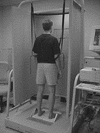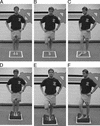Postural Stability and Neuropsychological Deficits After Concussion in Collegiate Athletes
- PMID: 12937495
- PMCID: PMC155417
Postural Stability and Neuropsychological Deficits After Concussion in Collegiate Athletes
Abstract
OBJECTIVE: Postural stability and neuropsychological testing are gradually becoming integral parts of postconcussion assessment in athletes. Clinicians, however, sometimes question the viability of instituting preseason baseline testing and the value of these results in making return-to-play decisions. Our purpose was to examine the course of recovery on various postural stability and neuropsychological measures after sport-related concussion. A secondary goal was to determine if loss of consciousness and amnesia, both of which are heavily weighted in most of the concussion classification systems, affect the rate of recovery. DESIGN AND SETTING: All subjects underwent a battery of baseline postural stability and neuropsychological tests before the start of their respective seasons. Any athletes subsequently injured were followed up at postinjury days 1, 3, and 5. Matched control subjects were assessed using the same test battery at the same time intervals. SUBJECTS: We studied 36 Division I collegiate athletes who sustained a concussion and 36 matched control subjects. MEASUREMENTS: We assessed postural stability using the Sensory Organization Test on the NeuroCom Smart Balance Master System and the Balance Error Scoring System. Neurocognitive functioning was measured with several neuropsychological tests: Trail-Making Test, Wechsler Digit Span Test, Stroop Color Word Test, and Hopkins Verbal Learning Test. RESULTS: Injured subjects demonstrated postural stability deficits, as measured on both the Sensory Organization Test and Balance Error Scoring System. These deficits were significantly worse than both preseason scores and matched control subjects' scores on postinjury day 1. Only the results on the Trail-Making Test B and Wechsler Digit Span Test Backward resulted in a logical recovery curve that could explain lowered neuropsychological performance due to concussive injury. Significant differences were revealed between the control and injured groups at day 1 postinjury, but a significant decline between baseline and postinjury scores was not demonstrated. Loss of consciousness and amnesia were not associated with increased deficits or slowed recovery on measures of postural stability or neurocognitive functioning. CONCLUSIONS: Athletes with cerebral concussion demonstrated acute balance deficits, which are likely the result of not using information from the vestibular and visual systems effectively. Neurocognitive deficits are more difficult to identify in the acute stages of concussion, although concentration, working memory, immediate memory recall, and rapid visual processing appear to be mildly affected. More research is necessary to determine the best neuropsychological test battery for assessing sport-related concussion.
Figures









Similar articles
-
Alternative approaches to the assessment of mild head injury in athletes.Med Sci Sports Exerc. 1997 Jul;29(7 Suppl):S213-21. doi: 10.1097/00005768-199707001-00003. Med Sci Sports Exerc. 1997. PMID: 9247918
-
Evaluation of neuropsychological domain scores and postural stability following cerebral concussion in sports.Clin J Sport Med. 2003 Jul;13(4):230-7. doi: 10.1097/00042752-200307000-00006. Clin J Sport Med. 2003. PMID: 12855925
-
Predicting Recovery Patterns After Sport-Related Concussion.J Athl Train. 2017 Mar;52(3):288-298. doi: 10.4085/1062-6050-52.1.12. J Athl Train. 2017. PMID: 28387552 Free PMC article.
-
Assessment of postural stability following sport-related concussion.Curr Sports Med Rep. 2003 Feb;2(1):24-30. doi: 10.1249/00149619-200302000-00006. Curr Sports Med Rep. 2003. PMID: 12831673 Review.
-
Postural control deficits identify lingering post-concussion neurological deficits.J Sport Health Sci. 2016 Mar;5(1):61-69. doi: 10.1016/j.jshs.2016.01.007. Epub 2016 Jan 11. J Sport Health Sci. 2016. PMID: 30356901 Free PMC article. Review.
Cited by
-
Using Accelerometer and Gyroscopic Measures to Quantify Postural Stability.J Athl Train. 2015 Jun;50(6):578-88. doi: 10.4085/1062-6050-50.2.01. Epub 2015 Apr 6. J Athl Train. 2015. PMID: 25844853 Free PMC article.
-
Knowledge, attitude, and concussion-reporting behaviors among high school athletes: a preliminary study.J Athl Train. 2013 Sep-Oct;48(5):645-53. doi: 10.4085/1062-6050-48.3.20. Epub 2013 Jul 12. J Athl Train. 2013. PMID: 23848520 Free PMC article.
-
Academic Outcomes in High-School Students after a Concussion: A Retrospective Population-Based Analysis.PLoS One. 2016 Oct 20;11(10):e0165116. doi: 10.1371/journal.pone.0165116. eCollection 2016. PLoS One. 2016. PMID: 27764223 Free PMC article.
-
Sports-related concussion testing.Curr Neurol Neurosci Rep. 2012 Oct;12(5):547-59. doi: 10.1007/s11910-012-0299-y. Curr Neurol Neurosci Rep. 2012. PMID: 22791281 Review.
-
Neuromotor changes in participants with a concussion history can be detected with a custom smartphone app.PLoS One. 2022 Dec 15;17(12):e0278994. doi: 10.1371/journal.pone.0278994. eCollection 2022. PLoS One. 2022. PMID: 36520862 Free PMC article.
References
LinkOut - more resources
Full Text Sources
Other Literature Sources
